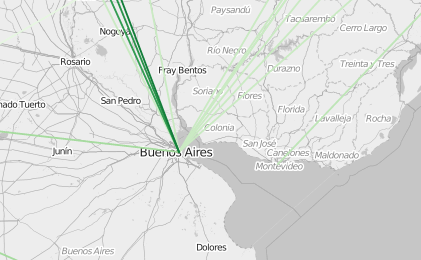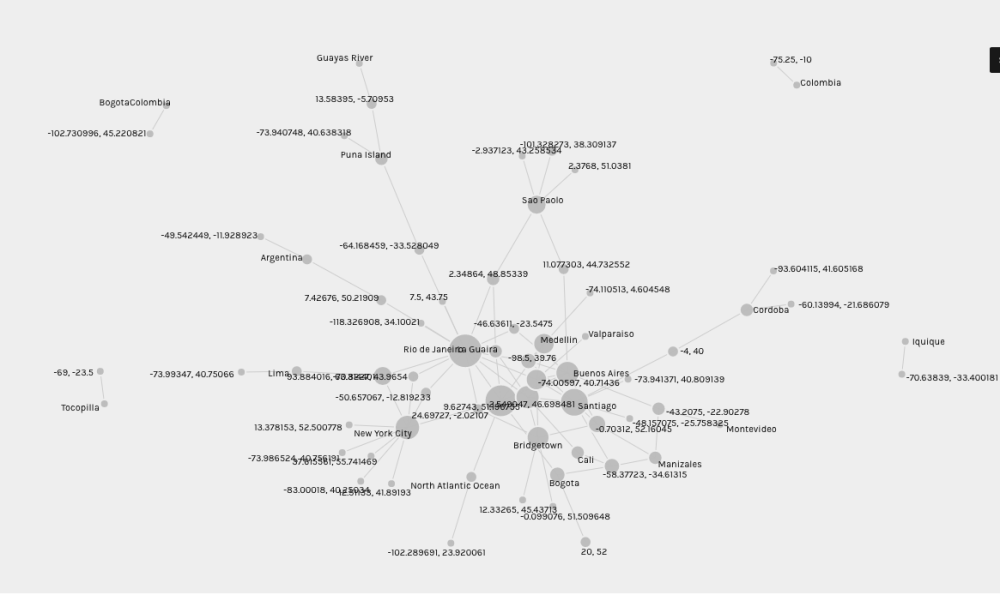With these maps, I take a break from the South American route itself to look instead at where the dancers and other travelers on the 1941 tour came from. This creates a (somewhat) more distributed picture of exchange than one might imagine when looking at only those singular lines that begin and end in New York harbor.
The data comes from a series of documents collected in preparation for travel visas, which required that dancers provide proof of birthplace, birthdate, and current citizenship. For most dancers born inside the United States, the lists are relatively straightforward, except where documentation had been lost. For those born in one of seven countries outside of the United States, there is additional information and dates for immigration status (“alien registration”, “first papers”), quota numbers, and cities of application. For some reason, Balanchine’s birthplace is never specified beyond “Russia.”
In manually collating the datasets, I focused primarily on place of birth and current citizenship, which are only two of the many possible ways to mark affiliations to place. A dancer born in London was domiciled in Montreal, worked in the US under a quota visa, but traveled under a valid Canadian passport. Two dancers born in different cities in Germany required extensive documentation, since they were officially listed as “stateless.” These examples suggest how many lives exceed the chosen anchors.
To take a general overview: the travelers were born in 36 cities across 8 countries: the United States, England, Germany, Mexico, Cuba, Australia, Russia, and Canada. Between them, their birthplaces touch several continents. New York City dominates the United States cities, followed by Philadelphia. Beyond what we think of now as the northeast corridor (New Jersey, Connecticut, Massachusetts, Pennsylvania), travelers came from Illinois, Ohio, Utah, Oklahoma, Washington, North Carolina, California, and Missouri. Dancers held citizenships in four countries, plus the stateless Germans, whose passports had been invalidated.
Here is a map marking places of birth. The coloring is by country, but specific city names appear when you hover over a particular dot:
Whereas here is a map where places of birth are colored by the travelers’ citizenship as of spring 1941, when they set out on tour:
Maps like these do not take into account, for example, the travels of dancers and other tour workers between their birth and the spring of 1941. For example, while northern California is not represented, two of the dancers had come from San Francisco Ballet. Likewise, the wardrobe mistress from Russia had actually been on Ballet Russes’s South American tour, and another dancer is listed as previously performing for “Monte Carlo,” although the dates are not specified.
But there is another map that I’d like to make even more. It’s a point to point map, based not on factual data such as this, but on the “fictional” novel written on tour. (Update: I did it and it’s here.) Each time a location is mentioned, I would draw a line between the city where the novel is when the other place is mentioned, and the reference. In this way, it would be possible to build a map of interconnected places from the perspective of those on tour. There are many decisions to make with this: would it need to distinguish between external and internal referents, ie: world events versus associations in the dancers’ own minds? What counts as a concrete enough reference to use? And how might enough lines ultimately warp the basemap to create a different picture of the world landscape?
In the meantime, one last map experiment that colors birthplace by company role to think a bit more about labor:

 will help to particularize the ways in which this relational map is being held together.
will help to particularize the ways in which this relational map is being held together.



 The historical maps do more than simply provide an accurate baselayer. For example, I have been wondering about some of the empty spaces on the maps that I have been creating so far. In other words, where didn’t the tour go and why? Or why choose these particular cities? I have been searching for other open datasets pertaining to South America in 1941, which might help answer such questions via population, GDP, etc. However, looking at the 1941 atlas, it is conspicuous that the most dominant lines and therefore the largest roads on the map trace out almost exactly the path taken by American Ballet Caravan (even though the company itself often traveled via other means). I’ve turned on the breadcrumbs in the cumulative animation, so that this pattern is visible.
The historical maps do more than simply provide an accurate baselayer. For example, I have been wondering about some of the empty spaces on the maps that I have been creating so far. In other words, where didn’t the tour go and why? Or why choose these particular cities? I have been searching for other open datasets pertaining to South America in 1941, which might help answer such questions via population, GDP, etc. However, looking at the 1941 atlas, it is conspicuous that the most dominant lines and therefore the largest roads on the map trace out almost exactly the path taken by American Ballet Caravan (even though the company itself often traveled via other means). I’ve turned on the breadcrumbs in the cumulative animation, so that this pattern is visible.
